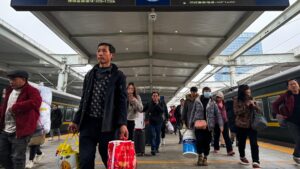Understanding the Current State of China’s Economy: Challenges and Opportunities
As we step into 2025, the hustle and bustle of major cities like Beijing and Chongqing capture a moment of hope amid challenging economic realities. The recent Spring Festival travel rush highlighted a yearning for normalcy as passengers streamed in and out of train stations. However, beneath the surface, China’s economic landscape remains fraught with uncertainty. At Extreme Investor Network, we delve deeper into these complexities, providing insights that set us apart in a crowded information space.
The Waiting Game for Economic Stimulus
Despite numerous promises from policymakers regarding fiscal support, China’s economy has not yet shown the turnaround that investors had anticipated. Since late September, we’ve witnessed interest rate cuts and broad stimulus announcements, yet specifics on fiscal measures are expected only during the parliamentary meetings slated for March. Furthermore, BlackRock Investment Institute’s observations point to a troubling trend: "China’s fiscal stimulus is not yet enough to address the drags on economic growth." As cautious optimism prevails, our experts at Extreme Investor Network remain vigilant, identifying key indicators that may signal a market shift.
Addressing Domestic Demand and Deflation Fears
One of the most worrying signals for the Chinese economy is the plummeting domestic demand, compounded by fears of deflation. Consumer prices witnessed a mere 0.5% increase in 2024—the slowest growth rate in over a decade. As Yin Yong, the Beijing city mayor, succinctly observed, “Consumer spending remains weak, foreign investment is declining, and some industries face growth pressure.”
At Extreme Investor Network, we emphasize the importance of monitoring consumer sentiment, as weak spending habits pose a significant challenge to recovery. The Chinese government’s initiatives to boost demand through trade-in subsidies for home appliances are noteworthy; however, experts suggest these measures may not be sufficient for a sustained recovery.
Real Estate Market on the Brink
Real estate has long been the backbone of China’s economic growth, contributing to over a quarter of its GDP prior to the crackdown on developers’ debt levels in 2020. Recent moves by the government to stabilize this crucial sector—such as allowing the completion of unsold properties—show a shift in strategy. Despite these initiatives, analysts warn that the sector has yet to hit rock bottom.
As highlighted by Jeremy Zook from Fitch Ratings, the commercial property market faces ongoing challenges. Beijing’s Grade A office rents dropped by 16% in 2024 and are projected to reduce further in 2025. Our analysis at Extreme Investor Network suggests that while recovery is on the horizon, investors should be cautious, especially in smaller cities where inventory levels suggest a prolonged downturn.
The Role of Trade-in Subsidies in Consumer Spending
China’s approach to stimulating consumer spending has diverged from the cash-handout strategies seen in the U.S. during the pandemic. Instead, the Chinese government has introduced substantial trade-in subsidies aimed at invigorating demand for home appliances and electric vehicles. With the rollout of 150 billion yuan in ultra-long bonds, authorities are attempting to shift consumer behavior towards more frequent upgrades.
However, opinions vary on the long-term efficacy of such programs. While some market experts, like Rex Chen of ATRenew, anticipate a boost in recycling and consumer engagement, skepticism remains regarding whether these measures will lead to sustained spending increases.
Navigating Geopolitical Headwinds
The geopolitical climate adds another layer of complexity to China’s economic landscape. Tensions with the U.S. have intensified, spurring both nations to reassess their strategic sectors. This places increasing pressure on European businesses operating in China, who must navigate localization to retain market access. At Extreme Investor Network, we advocate for a keen understanding of these wider dynamics, as they will inevitably influence investment decisions moving forward.
Conclusion: A Critical Eye on China’s Future
As China grapples with these multifaceted challenges, the road to economic recovery is undoubtedly fraught with obstacles. Policymakers are prioritizing consumption while recognizing that these efforts must be paired with increased investment efficiency. The upcoming parliamentary session is pivotal, and we at Extreme Investor Network will keep our readers informed of developments that could signal shifts in this complex economic narrative.
Staying attuned to these shifting landscapes is key to navigating investments in the Chinese market. By engaging with our unique insights and analyses, you can position yourself strategically as opportunities arise in an ever-evolving economic environment. Join us at Extreme Investor Network for more in-depth coverage, expert opinions, and emerging market trends.

